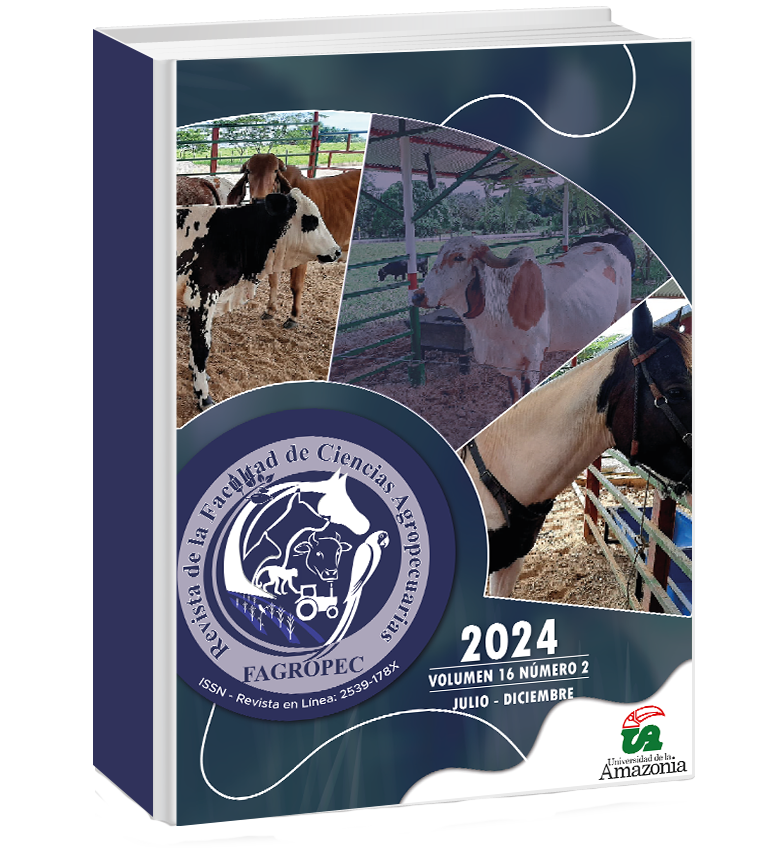español
DOI:
https://doi.org/10.47847/fagropec.v16n2a4Keywords:
Chlorpyrifos, Colombia, U.S. EPA, neurotoxicity, endocrine disruptor, regulationAbstract
The modeling of chlorpyrifos toxicity to human health is a classic example of how characterization of pesticide exposures can impact the policy of regulatory agencies. Until 2016, the American Environmental Protection Agency (EPA) relied on the inhibition of acetylcholinesterase (the biological effect most sensitive to the action of chlorpyrifos) to establish that the health risk to exposures of agricultural products with “tolerable” levels of chlorpyrifos was relatively low. By 2016, unreported findings from industry-funded studies, and new epidemiological studies between 2003 and 2014, showed that children exposed during pregnancy, documented by measurements of chlorpyrifos in umbilical blood, suffered major developmental and neurological disorders. In 2017-2020, analogous neurological disorders were reproduced in rats at doses lower than those that inhibited acetylcholinesterase. These studies in rats had no uncertainty about prenatal exposure levels. In August 2021, the EPA finally banned all uses of chlorpyrifos in the United States, while the European Union had already done so in January 2020. This shows that pesticide regulation policy can vary greatly depending on what scientific studies are used to assess health risks. In Colombia, the list of pesticides registered by ICA as of September 2021 includes 28 chlorpyrifos-based products for agricultural use, not counting those for livestock use. As long as there are no stricter environmental and public health laws in Colombia, chlorpyrifos will continue to be imported and commercialized from countries that have already banned them.
Downloads
References
Anon. (1998). Developmental neurotoxicity study of chlorpyrifos administered orally via gavage to Crl®BR VAF/Plus® presumed pregnant rats.
ATSDR [Agency for Toxic Substances and Disease Registry]. (2019). Toxic Substances Portal – Chlordane. Agency for Toxic Substances and Disease Registry, Centers for Disease Control and Prevention. Recuperado el 6 de diciembre de 2022 de https:// www.atsdr.cdc.gov/phs/phs.asp?id=353&tid=62
Attina, T. M., Hauser, R., Sathyanarayana, S., Hunt, P. A., Bourguignon, J. P., Myers, J. P., DiGangi, J., Zoeller, R. T., & Trasande, L. (2016). Exposure to endocrine-dis¬rupting chemicals in the USA: A population-based disease burden and cost analysis. The Lancet Diabetes & Endocrinology, 4(2), 996–1003. https://doi.org/10.1016/S2213- 8587(16)30275-3
Bellanger, M., Demeneix, B., Grandjean, P., Zoeller, R. T., & Trasande, L. (2015). Neuro¬behavioral deficits, diseases, and associated costs of exposure to endocrine-disrup¬ting chemicals in the European Union. Journal of Clinical Endocrinology & Metabolism, 100(4), 1256-1266. https://doi.org/10.1210/jc.2014-4323
Berg, E. L., Ching, T. M., Bruun, D. A., Rivera, J. K., Careaga, M., & Ellegood, J. (2020). Translational outcomes relevant to neurodevelopmental disorders following early life exposure of rats to chlorpyrifos. Neurotoxicity Research, 12(1), 40. https://doi.org/10.1186/s11689-020-09342-1
Cochran, R. C., Kishiyama, J., Aldous, C., Carr, W. C., & Pfeifer, K. F. (1995). Chlorpyrifos: Hazard assessment based on a review of the effects of short-term and long-term expo¬sure in animals and humans. Food and Chemical Toxicology, 33(2), 165-172. https:// doi.org/10.1016/0278-6915(94)00124-7
Coulston, F., Golberg, L., & Griffin, T. (1972). Safety evaluation of Dowco 179 in human volunteers. Report of the Institute of Experimental Pathology and Toxicology, Albany Medical College, Albany, New York. Recuperado de https://archive.epa.gov/osa/hsrb/web/pdf/1f3-science-rvw-coulston-052609.pdf
EFSA [European Food Safety Authority]. (2018). The 2016 European Union report on pesticide residues in food. EFSA Journal, 16(7), 5348. https://doi.org/10.2903/j.efsa.2018.5348
Engel, L. S., Werder, E., Satagopan, J., Blair, A., Hoppin, J. A., Koutros, S., Lerro, C. C., Sandler, D. P., Alavanja, M. C., & Beane-Freeman, L. E. (2017). Insecticide use and breast cancer risk among farmers’ wives in the Agricultural Health Study. Environmen-tal Health Perspectives, 125(9), 097002. https://doi.org/10.1289/EHP1295
EFSA [European Food Safety Authority]. (2019). Statement on the available outcomes of the human health assessment in the context of the pesticides peer review of the active substance chlorpyrifos. EFSA Journal, 17(8), 5809. https://doi.org/10.2903/j. efsa.2019.5809
Giesy, J. P., Solomon, K. R., Coats, J. R., Dixon, K. R., Giddings, J. M., & Kenaga, E. E. (1999). Chlorpyrifos: Ecological risk assessment in North American aquatic environ-ments. En Ware, G. W. (Ed.), Reviews of Environmental Contamination and Toxicology: Continuation of Residue Reviews (pp. 1-129). Springer. https://doi.org/10.1007/978-1-4612-1498-4_1
Health and Environment Alliance (HEAL). (2019). Pesticide Action Network Europe, Gé¬nérations Futures, & Pesticide Action Network Germany. Recuperado el 6 de diciem-bre de 2022, de https://www.env-health.org/wp-content/uploads/2019/06/June-2019- PAN-HEAL-Briefing-chlorpyrifos_web.pdf
ICA [Instituto Colombiano Agropecuario]. (2020). Boletín de estadísticas de comercializa¬ción de plaguicidas y herbicidas 2017-2019. https://www.ica.gov.co/getdoc/1908eb2c- 254f-44de-8e21-c322cc2a7e91/estadisticas.aspx
ICA [Instituto Colombiano Agropecuario]. (2021). Registro de plaguicidas por el ICA a sep¬tiembre de 2021. https://www.ica.gov.co/getdoc/d3612ebf-a5a6-4702-8d4b-8427c1c¬daeb1/registros-nacionales-pqua-15-04-09.aspx
ICA [Instituto Colombiano Agropecuario]. (2022). Registro de plaguicidas por el ICA a sep¬tiembre de 2022. https://www.ica.gov.co/areas/agricola/servicios/regulacion-y-con¬trol-de-plaguicidas-quimicos/estadisticas/estadisticas-pqua-2022-final.aspx
ICA [Instituto Colombiano Agropecuario]. (2023). Registro de plaguicidas por el ICA a
septiembre de 2023. https://www.ica.gov.co/getdoc/b240512d-0a30-4a59-9f00- 0c1fa47692b4/PRODUCCION-IMPORTACION-Y-EXPORTACION-PQUA-2023.aspx
Knaak, J. B., Yee, K., Ackerman, C. R., Zweig, G., Fry, D. M., & Wilson, B. W. (1984). Percutaneous absorption and dermal dose-cholinesterase response studies with pa-rathion and carbaryl in the rat. Toxicology and Applied Pharmacology, 76(2), 252-263. https://doi.org/10.1016/0041-008X(84)90006-1
Lulac vs. Wheeler. (2018). On petition for review of an order of the Environmental Pro-tection Agency. United States Court of Appeals for the Ninth Circuit. Argued and submitted. https://www.govinfo.gov/content/pkg/USCOURTS-ca9-20-70272/pdf/US-COURTS-ca9-20-70272-0.pdf
Marty, M. S., Andrus, A. K., Bell, M. P., Passage, J. K., Perala, A. W., Brzak, K. A., et al. (2012). Cholinesterase inhibition and toxicokinetics in immature and adult rats after acute or repeated exposures to chlorpyrifos or chlorpyrifos-oxon. Regulatory Toxicolo-gy and Pharmacology, 63(2), 209-224. https://doi.org/10.1016/j.yrtph.2012.03.015
Mie, A., Ruden, C., & Grandjean, P. (2018). Safety of safety evaluation of pesticides: De¬velopmental neurotoxicity of chlorpyrifos and chlorpyrifos-methyl. Environmental Heal¬th, 17, 77. https://doi.org/10.1186/s12940-018-0421-y
Nishi, K., & Singh-Hundal, S. (2013). Chlorpyrifos-induced toxicity in reproductive or-gans of female Wistar rats. Food and Chemical Toxicology, 62, 732–738. https://doi. org/10.1016/j.fct.2013.10.006
Perera, F. P., Rauh, V., Tsai, W. Y., Kinney, P., Camann, D., Barr, D., & et al. (2003). Effects of transplacental exposure to environmental pollutants on birth outcomes in a mul¬tiethnic population. Environmental Health Perspectives, 111(2), 201-205. https://doi. org/10.1289/ehp.5742
Rauh, V. A., Garfinkel, R., Perera, F. P., Andrews, H. F., Hoepner, L., Barr, D. B., et al. (2006). Impact of prenatal chlorpyrifos exposure on neurodevelopment in the first 3 years of life among inner-city children. Pediatrics, 118(6), e1845-e1859. https://doi. org/10.1542/peds.2006-0338
Rauh, V. A., Arunajadai, S., Horton, M., Perera, F., Hoepner, L., Barr, D. B., & Whyatt, R. (2011). Seven-year neurodevelopmental scores and prenatal exposure to chlorpyrifos, a common agricultural pesticide. Environmental Health Perspectives, 119(8), 1196- 1201. https://doi.org/10.1289/ehp.1003160
Rauh, V. A., Perera, F. P., Horton, M. K., Whyatt, R. M., Bansal, R., Hao, X., et al. (2012). Brain anomalies in children exposed prenatally to a common organophosphate pesti¬cide. Proceedings of the National Academy of Sciences, 109(20), 7871-7876. https:// doi.org/10.1073/pnas.1203396109
Russell, L. C., Armstrong, N. H., Buchanan, A. T., Eells, J. B., Mohammed, A. N., Ross, M. K., & Nail, C. A. (2017). Decreased anxiety in juvenile rats following exposure to low levels of chlorpyrifos during development. Neurotoxicology, 59, 183-190. https://doi. org/10.1016/j.neuro.2015.11.016
Sheppard, L., McGrew, S., & Fenske, R. A. (2020). Flawed analysis of an intentional human dosing study and its impact on chlorpyrifos risk assessment. Environmental International, 143, 105905. https://doi.org/10.1016/j.envint.2020.105905
U.S. EPA [Environmental Protection Agency]. (1985). History (1970-1985). Recupera-do el 10 de noviembre de 2021 de https://archive.epa.gov/epa/aboutepa/epa-his¬tory-1970-1985.html
U.S. EPA [Environmental Protection Agency]. (1987). Guidance for the reregistration of pesticide products containing chlorpyrifos as the active ingredient 059101. Recupe-rado el 6 de diciembre de 2022 de https://nepis.epa.gov/Exe/ZyPURL.cgi?Dockey=-9101VKUO.TXT
U.S. EPA [Environmental Protection Agency]. (1997). Agreement reached between EPA and chlorpyrifos pesticide registrants. Press Advisory, Communications, Education and Public Affairs. Recuperado el 6 de diciembre de 2022 de https://www.epa.gov/archive/ epapages/newsroom_archive/newsreleases/e907eeff3f785ccd852564ae0050269c. html
U.S. EPA [Environmental Protection Agency]. (1998). Chlorpyrifos – FQPA requirement. Report of the Hazard Identification Assessment Review Committee, Office of Pesticide Programs. Recuperado el 6 de diciembre de 2022 de https://archive.epa.gov/scipoly/ sap/meetings/web/pdf/hed_ra.pdf
U.S. EPA [Environmental Protection Agency]. (2004). Overview of the ecological risk as¬sessment process in the Office of Pesticide Programs. Office of Prevention, Pesticides, and Toxic Substances, Office of Pesticide Programs. Recuperado el 6 de diciembre de 2022 de https://www.epa.gov/sites/default/files/2014-11/documents/ecorisk-overview. pdf
U.S. EPA [Environmental Protection Agency]. (2006). Reregistration Eligibility Decision (RED) for Chlorpyrifos. Recuperado de https://www3.epa.gov/pesticides/chem_ search/reg_actions/reregistration/red_PC-059101_1-Jul-06.pdf
U.S. EPA [Environmental Protection Agency]. (2009a). Risks of chlorpyrifos use to fe-derally threatened & endangered species: California red-legged frog (Rana aurora draytonii), California tiger salamander (Ambystoma californiense), San Francisco gar-ter snake (Thamnophis sirtalis tetrataenia), California clapper rail (Rallus longirostris obsoletus), salt marsh harvest mouse (Reithrodontomys raviventris), Bay checkerspot butterfly (Euphydryas editha bayensis), valley elderberry longhorn beetle (Desmoce¬rus californicus dimorphus), San Joaquin kit fox (Vulpes macrotis mutica), California freshwater shrimp (Syncaris pacifica), and Delta smelt (Hypomesus transpacificus). Environmental Fate and Effects Division, Office of Pesticide Information. Recupera¬do el 6 de diciembre de 2022 de https://www3.epa.gov/pesticides/endanger/litstatus/ effects/redleg-frog/chlorpyrifos/analysis.pdf
U.S. EPA [Environmental Protection Agency]. (2009b). Withdrawal of Coulston et al. chlor¬pyrifos toxicity study from HSRB agenda. Memorándum de D. Edwards, Director, Offi¬ce of Pesticide Programs, a P. I. Lewis, Designated Federal Officer, Human Studies Review Board, Office of the Science Advisor, Office of Pesticides and Toxic Substan-ces. Recuperado el 6 de diciembre de 2022 de https://www.sciencedirect.com/scien¬
ce/article/pii/S0160412020318602
U.S. EPA [Environmental Protection Agency]. (2011). Chlorpyrifos: Preliminary human health risk assessment for registration. Office of Chemical Safety and Pollution Pre-vention. Recuperado el 6 de diciembre de 2022 de https://www.regulations.gov/docu-ment/EPA-HQ-OPP-2008-0850-0025
U.S. EPA [Environmental Protection Agency]. (2016). Chlorpyrifos: Revised human health risk assessment for registration review. Office of Chemical Safety and Pollution Pre¬vention. Recuperado el 6 de diciembre de 2022 de https://www.regulations.gov/docu¬ment/EPA-HQ-OPP-2015-0653-0454
U.S. EPA [Environmental Protection Agency]. (2017). Chlorpyrifos: Order denying PANNA and NRDC’s petition to revoke tolerances, 82 Fed. Reg. 16, 581 (April 5). Recuperado el 6 de diciembre de 2022 de https://www.epa.gov/sites/production/files/2017-03/do-cuments/chlorpyrifos3b_order_denying_panna_and_nrdc27s_petitition_to_revoke_ tolerances.pdf
U.S. EPA [Environmental Protection Agency]. (2019). Basic information about human sub¬jects research. Office of the Science Advisor. Recuperado el 6 de diciembre de 2022 de https://www.epa.gov/osa/basic-information-about-human-subjects-research-0
U.S. EPA [Environmental Protection Agency]. (2021). Tolerance Revocations: Chlorpyri¬fos. Recuperado el 6 de diciembre de 2022 de https://www.regulations.gov/document/ EPA-HQ-OPP-2021-0523-0001
U.S. Geological Survey (USGS). (2021). National Water-Quality Assessment (NAWQA) Project. Recuperado el 10 de noviembre de 2021 de https://water.usgs.gov/nawqa/ pnsp/usage/maps/compound_listing.php
Van Wendel de Joode, B., Mora, A. M., Cordoba, L., Quesada, R., Cano, J. C., Faniband, M., Hoppin, J., Eskenazi, B., & Lindh, C. (2014). In utero mancozeb and chlorpyrifos exposure is associated with decreased fetal growth in the Infants’ Environmental Heal¬th Study (ISA), Costa Rica. ISEE Conference Abstracts, 2014(1), 2823. https://doi. org/10.1289/isee.2014.O-075
Van Wendel de Joode, B., Mora, A. M., Lindh, C. H., Hernández-Bonilla, D., Córdoba, L., Wesseling, C., Hoppin, J. A., & Mergler, D. (2016). Pesticide exposure and neurodeve¬lopment in children aged 6-9 years from Talamanca, Costa Rica. Cortex, 85, 137-150. https://doi.org/10.1016/j.cortex.2016.09.003
Ventura, C., Ramos-Nieto, M. R., Bourguignon, N., Lux-Lantos, V., Rodríguez, H., Cao, G., Randi, A., Cocca, C., Nuñez, M., Clara, et al. (2016). Pesticide chlorpyrifos acts as an endocrine disruptor in adult rats causing changes in mammary gland and hormonal balance. Journal of Steroid Biochemistry and Molecular Biology, 156, 1–9. https://doi. org/10.1016/j.jsbmb.2015.10.010
Whyatt, R. M., Camann, D., Perera, F. P., Rauh, V. A., Tang, D., Kinney, P. L., et al. (2005). Biomarkers in assessing residential insecticide exposures during pregnancy and effects on fetal growth. Toxicology and Applied Pharmacology, 206(2), 246-254. https://doi.org/10.1016/j.taap.2004.11.027
World Health Organization & Food and Agriculture Organization of the United Nations. (1974). Pesticide residues in food: Report of the 1973 Joint Meeting of the FAO Wor-king Party of Experts on Pesticide Residues and the WHO Expert Committee on Pesti-cide Residues, Geneva, 26 November – 5 December 1973. World Health Organization
Downloads
Published
Issue
Section
License

This work is licensed under a Creative Commons Attribution-NonCommercial-ShareAlike 4.0 International License.
























